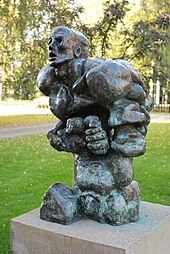Ernst Iossifowitsch Neiswestny
Ernst Iossifowitsch Neiswestny ( Russian Эрнст Иосифович Неизвестный , scientific transliteration Ėrnst Iosifovič Neizvestnyj ; born April 9, 1925 in Sverdlovsk ; † August 9, 2016 in New York ) was a Soviet or Russian sculptor .
Life
Ernst Neiswestny was born in Sverdlovsk (now Yekaterinburg ) in 1925 . In the 1930s, his parents fell victim to the Stalinist purges .
At the age of 17 he volunteered for the Red Army . At the end of the Great Patriotic War , he was badly wounded and reported dead. Allegedly posthumously he was awarded the Order of the Red Banner , his family was sent the official notice of death. However, contrary to all expectations, Neiswestny had survived.
In 1947 he enrolled at the Art Academy in Riga one. He then continued his studies at the Surikov Institute in Moscow and at the philosophical faculty of Lomonossow University .
His sculptures were often composed of parts of the human body. He preferred to make sculptures out of bronze , but the monumental sculptures are made out of concrete. Neiswestny combined the most famous monumental works in one cycle, on which he had been working since 1956. The sculpture "Tree of Life" is considered the best work of this cycle.
Neiswestny was criticized for his work by the then Soviet state and party leader Nikita Khrushchev , who described the sculptures at an exhibition in 1962 as " degenerate art ". Khrushchev asked: "Why do you distort the faces of the Soviet people?" Neiswestny later created a sculpture of Khrushchev, which was placed on his grave. The design of the grave was carried out by Neiswestny at the express request of Khrushchev.
The most important works from the Soviet era are “Prometheus” in the Artek pioneer camp (1966) and “Lotus Blossom” near the Aswan Dam in Egypt (1971).
In 1976 Neiswestny emigrated to the USA via Switzerland .
In the 1980s, Neiswestny lectured at the universities of Oregon and Berkeley . It had several successful exhibitions at the Magna Gallery in San Francisco . In 1990 he created the cycle “Man through the Wall”, a work commissioned by Magna Gallery, which is dedicated to the revolutions of 1989 .
In 1996 Neiswestny finished his 15 m high monumental work " Mask of Mourning ", which is dedicated to the victims of repression in the Soviet Union. The sculpture was erected in Magadan . In the same year Neiswestny received the State Prize of the Russian Federation .
In 2000 he was awarded the Order of Honor .
Until his death Neiswestny lived in New York and worked at the University of Columbia .
In Uttersberg in Sweden there is a museum with Neiswestnys sculptures. Some of his sculptures were purchased by Pope John Paul II for the Vatican Museums . In the Serbian spa town of Vrnjačka Banja , two of his sculptures are in the open air in the city park. This is unique in the world.
literature
- Ernst Neiswestnij , in: Internationales Biographisches Archiv 05/2005 of February 5, 2005, in the Munzinger archive ( beginning of article freely available)
Individual evidence
- ↑ Russian-American sculptor Ernst Neizvestny dies in New York . TASS , August 10, 2016, accessed on August 12, 2016.
- ↑ Vladimir Putin : Указ Президента Российской Федерации от April 6, 2000 г. № 643 О награждении орденом Почета Неизвестного Э.И. April 6, 2000, accessed on August 12, 2016 (Russian, "Decree of the President of the Russian Federation of April 6, 2000 N 643, On Awarding EI Neiswestnys with the Order of Honor" ").
Web links
- Short biography (Russian)
- Studio of Ernst Neizvestny web site (english)
- Kolodzei Art Foundation and the Kolodzei Collection of Russian and Eastern European Art (English)
- Sculptor Ernst Neizvestny (English)
| personal data | |
|---|---|
| SURNAME | Neiswestny, Ernst Iossifowitsch |
| ALTERNATIVE NAMES | Неизвестный, Эрнст Иосифович (Russian); Neizvestnyj, Ėrnst Iosifovič (scientific transliteration) |
| BRIEF DESCRIPTION | Soviet or Russian sculptor |
| DATE OF BIRTH | April 9, 1925 |
| PLACE OF BIRTH | Sverdlovsk |
| DATE OF DEATH | August 9, 2016 |
| Place of death | new York |


